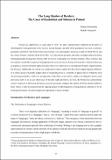Files in this item
The long shadow of borders : the cases of Kashubian and Silesian in Poland
Item metadata
| dc.contributor.author | Kamusella, Tomasz Dominik | |
| dc.contributor.author | Nomachi, Motoki | |
| dc.date.accessioned | 2014-12-18T10:01:02Z | |
| dc.date.available | 2014-12-18T10:01:02Z | |
| dc.date.issued | 2014 | |
| dc.identifier.citation | Kamusella , T D & Nomachi , M 2014 , ' The long shadow of borders : the cases of Kashubian and Silesian in Poland ' , Eurasia Border Review , vol. 5 , no. 2 , pp. 35-60 . | en |
| dc.identifier.issn | 1884-9466 | |
| dc.identifier.other | PURE: 159790034 | |
| dc.identifier.other | PURE UUID: 3f97ea36-8fc7-4907-a60f-ae17f32b1e57 | |
| dc.identifier.other | ORCID: /0000-0003-3484-8352/work/42102714 | |
| dc.identifier.uri | https://hdl.handle.net/10023/5936 | |
| dc.description.abstract | Poland was established as a nation-state in 1918. The state’s administration embarked on the policy of ethnolinguistic homogenization in the interwar period, because one-third of the population was seen as ethnolinguistically non-Polish. The Polish borders and territory were dramatically altered as a result of World War II, and the country became a member of the Soviet bloc. The concomitant genocide and ethnic cleansing yielded an almost ethnolinguistically homogenous Poland. After the end of communism, the German minority, whose existence had been denied, was finally recognized. In preparation for accession into the European Union (EU), Poland worked out, as required, a system of minority rights protection. However, it did not cover contemporary Poland’s largest minority, the Silesians. Additionally, the system was constructed in such a manner that the acknowledged linguistic difference of a similar group of Kashubs stopped short of recognizing them as a minority. It appears that in Poland the need for protecting minorities is felt to be an imposition of the West, or the old EU, which was not obliged to observe such provisions itself. In its de jure observance of minority rights provisions, de facto, the Polish state administration seems to endeavor to limit such provisions as much as possible, alongside the number of Polish citizens entitled to them. Hence, it may be proposed that the ongoing project of ethnolinguiustic homogenization continues to be the ideological backbone of national statehood legitimation in today’s Poland. | |
| dc.language.iso | eng | |
| dc.relation.ispartof | Eurasia Border Review | en |
| dc.rights | Copyright 2014 Eurasia Border Review. Reproduced with permission from the editors. | en |
| dc.subject | Kashubian language | en |
| dc.subject | Silesian language | en |
| dc.subject | Poland | en |
| dc.subject | discrimination | en |
| dc.subject | Polonization | en |
| dc.subject | assimilation | en |
| dc.subject | recognition of languages | en |
| dc.subject | recognition of ethnic groups | en |
| dc.subject | JN Political institutions (Europe) | en |
| dc.subject | D901 Europe (General) | en |
| dc.subject | SDG 16 - Peace, Justice and Strong Institutions | en |
| dc.subject.lcc | JN | en |
| dc.subject.lcc | D901 | en |
| dc.title | The long shadow of borders : the cases of Kashubian and Silesian in Poland | en |
| dc.type | Journal article | en |
| dc.description.version | Publisher PDF | en |
| dc.contributor.institution | University of St Andrews. School of History | en |
| dc.description.status | Peer reviewed | en |
| dc.identifier.url | http://src-h.slav.hokudai.ac.jp/publictn/eurasia_border_review/ebr_v5n2/EBR_v5n2_35.pdf | en |
This item appears in the following Collection(s)
Items in the St Andrews Research Repository are protected by copyright, with all rights reserved, unless otherwise indicated.

